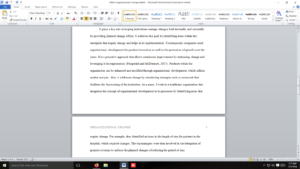PLEASE SEE ATTACHED
Review the case study “Alaska Airlines: Navigating Change” and then complete the following: (a) State what actually occurred in the case regarding Kotter’s steps 5 and 6 of empowering employees for broad-based action and generating short-term wins, and (b) address each of the critical elements for Section II parts E and F in your change effort analysis. Make sure to include your recommendations for implementing Kotter’s steps 5 and 6.
E. Enable Action by Removing Barriers
- Identify the forces, barriers, and hindrances to the organizational change effort, and describe each.
- How can resistance be recognized? How will you eliminate resistance or mitigate its impact on the implementation of the change plan?
- Describe actions that will enable and empower employees to help drive the change effort.
F. Generate Short-Term Wins
- Determine how you will generate short-term wins. How will you reward these wins?
- What can be gained from short-term wins? Support your response.
Guidelines for Submission: Your paper must be submitted as a 3–6-page Microsoft Word document with double spacing, 12-point Times New Roman font, oneinch margins, and at least three sources cited in APA format.
Requirements: 3-6 PAGES
Answer preview
Kotter (1996), in the Leading Change, indicated three major functions as necessary in step 6: (1) plan for performance improvements, (2) create improvements, and (3) recognize and reward the employees for those improvements. The short-term wins will be generated from the improvement of operational processes in the airline. The most significant intervention is to train the customer services staff on competitive customer relations to enhance customer satisfaction. The rewards for these wins will include congratulatory messages and bonuses for improved performances. The objective is to enhance the employee’s morale to attend to the unique needs of customer groups (Rafferty & Jimmieson, 2016). Customers service training can enhance and improve how the staff relates with customer groups, including the elderly, children, and other vulnerable groups. This is important to yield strong brand equity, eventually transitioning to competitive advantage. From a human resource perspective, morale and enthusiasm for the customers’ needs are key indicators of the potential for better performance. Moreover, it is a key measure of the employee’s long-term commitment to the company’s strategic initiatives.
[1052 Words]



